Attractions · Europe · Going Out · Italy · Regions · Western Europe
6 must-see historical sights to visit in Rome
Rome is one of those destinations that everyone must visit at least once in their life but with a city brimming with iconic historic structures and countless things to do deciding on where to visit can become an unwelcomed responsibility. To ease the burden, we have selected 6 must see historical sights to visit in Rome.
So come discover some of the richest, fullest history of any city on earth, stretching back some two-and-a-half thousand years
 Colosseum
First on any whistle-stop tour of Rome has to be the instantly recognisable Roman Colosseum. A sigil of Roman decadence and power, the Colosseum is an impressive sight to behold towering piers, arches and podiums comprise a 165ft high amphitheatre, which in its day, contained between 45,000 and 50,000 spectators. As any school history book will tell you, the Colosseum was used to host elaborate gladiatorial games and fights to the death. Although the notion of Christians being fed to the lions is as much a dramatisation as the games themselves, the inclusion of animals is not indeed, exotic and often dangerous animals captured in Africa and the Middle East were released into the arena to battle-it-out with humans. Thankfully, today no such battles take place but thats not to say its no less thrilling! Open all-year round, visitors can tour the ruins and wander amongst the labyrinth of chambers and passages that were once hidden beneath the floor of the Colosseum.
Colosseum
First on any whistle-stop tour of Rome has to be the instantly recognisable Roman Colosseum. A sigil of Roman decadence and power, the Colosseum is an impressive sight to behold towering piers, arches and podiums comprise a 165ft high amphitheatre, which in its day, contained between 45,000 and 50,000 spectators. As any school history book will tell you, the Colosseum was used to host elaborate gladiatorial games and fights to the death. Although the notion of Christians being fed to the lions is as much a dramatisation as the games themselves, the inclusion of animals is not indeed, exotic and often dangerous animals captured in Africa and the Middle East were released into the arena to battle-it-out with humans. Thankfully, today no such battles take place but thats not to say its no less thrilling! Open all-year round, visitors can tour the ruins and wander amongst the labyrinth of chambers and passages that were once hidden beneath the floor of the Colosseum.
 The Roman Forum and Palatine Hill
Just around the corner from the Colosseum are the tumbledown remains of what were once great Roman structures, The Roman Forum and Palatine Hill. Today, these impressive ruins serve as reminders of what were once a grandiose district of temples, basilicas, bustling markets at the centre of Roman public life. Like with so many of Ancient Romes showpiece structures, the Forum and Palatine Hill fell into disrepair and were plundered for their precious stone and marble, before eventually being converted into a pasture.
The Roman Forum and Palatine Hill are located in the same archaeological complex and are included as one admission. At first glance, the ruins appear to be just that, ruins, and that is why we would advise you to book a tour guide or rent an audio device so to better understand what you are seeing and to bring the place alive.
As you begin your tour, the ruins begin to reveal their history as visitors discover the spot where Julius Caesar was cremated, Tempio di Giulio Cesare, and the remnants of the Rostrum the podium from which Mark Anthony made his famous speech in the fictionalised drama, Anthony and Cleopatra, by William Shakespeare. While on Palatine Hill visitors can explore the centremost of the Seven Hills of Rome, one of the most ancient parts of Rome and tread between the excavated foundations of the once grand villas and residences.
The Roman Forum and Palatine Hill
Just around the corner from the Colosseum are the tumbledown remains of what were once great Roman structures, The Roman Forum and Palatine Hill. Today, these impressive ruins serve as reminders of what were once a grandiose district of temples, basilicas, bustling markets at the centre of Roman public life. Like with so many of Ancient Romes showpiece structures, the Forum and Palatine Hill fell into disrepair and were plundered for their precious stone and marble, before eventually being converted into a pasture.
The Roman Forum and Palatine Hill are located in the same archaeological complex and are included as one admission. At first glance, the ruins appear to be just that, ruins, and that is why we would advise you to book a tour guide or rent an audio device so to better understand what you are seeing and to bring the place alive.
As you begin your tour, the ruins begin to reveal their history as visitors discover the spot where Julius Caesar was cremated, Tempio di Giulio Cesare, and the remnants of the Rostrum the podium from which Mark Anthony made his famous speech in the fictionalised drama, Anthony and Cleopatra, by William Shakespeare. While on Palatine Hill visitors can explore the centremost of the Seven Hills of Rome, one of the most ancient parts of Rome and tread between the excavated foundations of the once grand villas and residences.
 Pantheon
A tourist favourite, the Pantheon is in remarkable condition and is one of the best preserved buildings dating from ancient Rome. This 2,000 year-old temple, known as the Basilica di Santa Maria ad Martyres, boasts original bronze doors and the famous Agrippas inscription: M:AGRIPPA.L.F.COS.TERTIUM.FECIT above its entrance.
Even after 2,000 years the Pantheon has still not lost any of its charm and continues to beguile and amaze visitors. Although the once gilded dome located at its centre has long been stripped of its bronze plating, it still features the iconic oculus that still acts as the primary light-source for the building. Exposed to the elements, the oculus has never been obstructed and continues to allow rain water to fall into the interior before being channelled away by the concaved floor and original Roman drainage system. It is said that the mathematical genius of its design and ascetic beauty inspired a generation of Renaissance artists and architects including Michelangelo.
Pantheon
A tourist favourite, the Pantheon is in remarkable condition and is one of the best preserved buildings dating from ancient Rome. This 2,000 year-old temple, known as the Basilica di Santa Maria ad Martyres, boasts original bronze doors and the famous Agrippas inscription: M:AGRIPPA.L.F.COS.TERTIUM.FECIT above its entrance.
Even after 2,000 years the Pantheon has still not lost any of its charm and continues to beguile and amaze visitors. Although the once gilded dome located at its centre has long been stripped of its bronze plating, it still features the iconic oculus that still acts as the primary light-source for the building. Exposed to the elements, the oculus has never been obstructed and continues to allow rain water to fall into the interior before being channelled away by the concaved floor and original Roman drainage system. It is said that the mathematical genius of its design and ascetic beauty inspired a generation of Renaissance artists and architects including Michelangelo.
 Spanish Steps
You would never think it, but it is believed that the Spanish Steps are the most photographed attraction in Italy which is quite an accomplishment in a city bursting with as many sites and attractions as Rome. Now returning after a years hiatus to be repaired and renovated, the Spanish Steps are once again open to the public.
Visitors will be in good company as they ascend the steps of the famous stairway, joining the likes of Audrey Hepburn and Gregory Peck who shared a scene there in the Hollywood classic, Roman Holiday, and Matt Damon in the film version of The Talented Mr Ripley. Visitors will revel in the seasonal and festive changes the steps undergo throughout the year, including the assembling of a Christmas manger on the first landing.
Spanish Steps
You would never think it, but it is believed that the Spanish Steps are the most photographed attraction in Italy which is quite an accomplishment in a city bursting with as many sites and attractions as Rome. Now returning after a years hiatus to be repaired and renovated, the Spanish Steps are once again open to the public.
Visitors will be in good company as they ascend the steps of the famous stairway, joining the likes of Audrey Hepburn and Gregory Peck who shared a scene there in the Hollywood classic, Roman Holiday, and Matt Damon in the film version of The Talented Mr Ripley. Visitors will revel in the seasonal and festive changes the steps undergo throughout the year, including the assembling of a Christmas manger on the first landing.
 Vatican City
This miniscule sovereign state may be the smallest country in the world, one that fits comfortably within the centre of Rome, but what it lacks in size it makes up for in significance. For Catholics the world over, The Vatican City is the beating heart and centre of Christendom. Not only is the Vatican home to the papal residence, it is also home to popular landmarks, St Peters Basilica, the Sistine Chapel and the Vatican Museums.
Vatican City
This miniscule sovereign state may be the smallest country in the world, one that fits comfortably within the centre of Rome, but what it lacks in size it makes up for in significance. For Catholics the world over, The Vatican City is the beating heart and centre of Christendom. Not only is the Vatican home to the papal residence, it is also home to popular landmarks, St Peters Basilica, the Sistine Chapel and the Vatican Museums.
 St Peters Basilica & the Sistine Chapel
Residing prominently in the centre of Vatican City is the iconic domed church of St Peters Basilica. Constructed atop of Vatican Hill by Emperor Constantine, the first Christian ruler of Rome, the basilica marks the resting place of the apostle, Saint Peter. The distinctive structure we know today is owed in part to the design of the renowned sculptor, artist and architect Michelangelo, who was handed control of the restoration of the basilica in 1547.
One of the best ways to appreciate the basilica is to ascend the steps or take the lift to the top of the cupola (or dome) atop the church to the viewing platforms. Although said to be an uneasy climb, visitors are rewarded with views that are dubbed as being some of the best in the city.
Finally, the extravagantly designed and intricately decorated with hand-painted frescoes, the Sistine Chapel is one of Vatican Citys great treasures. But its what lies above that is the real crowning glory, if you crane your necks upwards you are rewarded with Michelangelos most famous of frescoes which covers every inch of the ceiling.
St Peters Basilica & the Sistine Chapel
Residing prominently in the centre of Vatican City is the iconic domed church of St Peters Basilica. Constructed atop of Vatican Hill by Emperor Constantine, the first Christian ruler of Rome, the basilica marks the resting place of the apostle, Saint Peter. The distinctive structure we know today is owed in part to the design of the renowned sculptor, artist and architect Michelangelo, who was handed control of the restoration of the basilica in 1547.
One of the best ways to appreciate the basilica is to ascend the steps or take the lift to the top of the cupola (or dome) atop the church to the viewing platforms. Although said to be an uneasy climb, visitors are rewarded with views that are dubbed as being some of the best in the city.
Finally, the extravagantly designed and intricately decorated with hand-painted frescoes, the Sistine Chapel is one of Vatican Citys great treasures. But its what lies above that is the real crowning glory, if you crane your necks upwards you are rewarded with Michelangelos most famous of frescoes which covers every inch of the ceiling.
 Nick Munday is Managing Director at Classic Collection Holidays.
If you would like to be a guest blogger on A Luxury Travel Blog in order to raise your profile, please contact us.
Nick Munday is Managing Director at Classic Collection Holidays.
If you would like to be a guest blogger on A Luxury Travel Blog in order to raise your profile, please contact us.
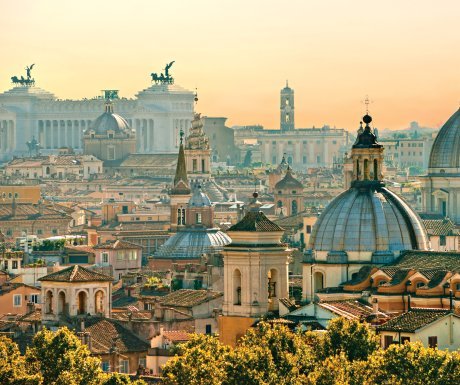 Colosseum
First on any whistle-stop tour of Rome has to be the instantly recognisable Roman Colosseum. A sigil of Roman decadence and power, the Colosseum is an impressive sight to behold towering piers, arches and podiums comprise a 165ft high amphitheatre, which in its day, contained between 45,000 and 50,000 spectators. As any school history book will tell you, the Colosseum was used to host elaborate gladiatorial games and fights to the death. Although the notion of Christians being fed to the lions is as much a dramatisation as the games themselves, the inclusion of animals is not indeed, exotic and often dangerous animals captured in Africa and the Middle East were released into the arena to battle-it-out with humans. Thankfully, today no such battles take place but thats not to say its no less thrilling! Open all-year round, visitors can tour the ruins and wander amongst the labyrinth of chambers and passages that were once hidden beneath the floor of the Colosseum.
Colosseum
First on any whistle-stop tour of Rome has to be the instantly recognisable Roman Colosseum. A sigil of Roman decadence and power, the Colosseum is an impressive sight to behold towering piers, arches and podiums comprise a 165ft high amphitheatre, which in its day, contained between 45,000 and 50,000 spectators. As any school history book will tell you, the Colosseum was used to host elaborate gladiatorial games and fights to the death. Although the notion of Christians being fed to the lions is as much a dramatisation as the games themselves, the inclusion of animals is not indeed, exotic and often dangerous animals captured in Africa and the Middle East were released into the arena to battle-it-out with humans. Thankfully, today no such battles take place but thats not to say its no less thrilling! Open all-year round, visitors can tour the ruins and wander amongst the labyrinth of chambers and passages that were once hidden beneath the floor of the Colosseum.
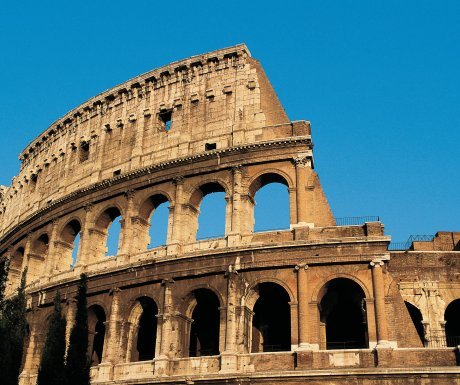 The Roman Forum and Palatine Hill
Just around the corner from the Colosseum are the tumbledown remains of what were once great Roman structures, The Roman Forum and Palatine Hill. Today, these impressive ruins serve as reminders of what were once a grandiose district of temples, basilicas, bustling markets at the centre of Roman public life. Like with so many of Ancient Romes showpiece structures, the Forum and Palatine Hill fell into disrepair and were plundered for their precious stone and marble, before eventually being converted into a pasture.
The Roman Forum and Palatine Hill are located in the same archaeological complex and are included as one admission. At first glance, the ruins appear to be just that, ruins, and that is why we would advise you to book a tour guide or rent an audio device so to better understand what you are seeing and to bring the place alive.
As you begin your tour, the ruins begin to reveal their history as visitors discover the spot where Julius Caesar was cremated, Tempio di Giulio Cesare, and the remnants of the Rostrum the podium from which Mark Anthony made his famous speech in the fictionalised drama, Anthony and Cleopatra, by William Shakespeare. While on Palatine Hill visitors can explore the centremost of the Seven Hills of Rome, one of the most ancient parts of Rome and tread between the excavated foundations of the once grand villas and residences.
The Roman Forum and Palatine Hill
Just around the corner from the Colosseum are the tumbledown remains of what were once great Roman structures, The Roman Forum and Palatine Hill. Today, these impressive ruins serve as reminders of what were once a grandiose district of temples, basilicas, bustling markets at the centre of Roman public life. Like with so many of Ancient Romes showpiece structures, the Forum and Palatine Hill fell into disrepair and were plundered for their precious stone and marble, before eventually being converted into a pasture.
The Roman Forum and Palatine Hill are located in the same archaeological complex and are included as one admission. At first glance, the ruins appear to be just that, ruins, and that is why we would advise you to book a tour guide or rent an audio device so to better understand what you are seeing and to bring the place alive.
As you begin your tour, the ruins begin to reveal their history as visitors discover the spot where Julius Caesar was cremated, Tempio di Giulio Cesare, and the remnants of the Rostrum the podium from which Mark Anthony made his famous speech in the fictionalised drama, Anthony and Cleopatra, by William Shakespeare. While on Palatine Hill visitors can explore the centremost of the Seven Hills of Rome, one of the most ancient parts of Rome and tread between the excavated foundations of the once grand villas and residences.
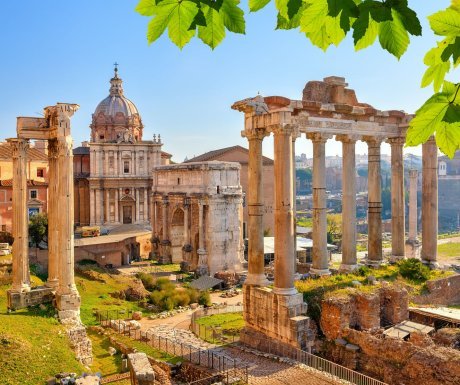 Pantheon
A tourist favourite, the Pantheon is in remarkable condition and is one of the best preserved buildings dating from ancient Rome. This 2,000 year-old temple, known as the Basilica di Santa Maria ad Martyres, boasts original bronze doors and the famous Agrippas inscription: M:AGRIPPA.L.F.COS.TERTIUM.FECIT above its entrance.
Even after 2,000 years the Pantheon has still not lost any of its charm and continues to beguile and amaze visitors. Although the once gilded dome located at its centre has long been stripped of its bronze plating, it still features the iconic oculus that still acts as the primary light-source for the building. Exposed to the elements, the oculus has never been obstructed and continues to allow rain water to fall into the interior before being channelled away by the concaved floor and original Roman drainage system. It is said that the mathematical genius of its design and ascetic beauty inspired a generation of Renaissance artists and architects including Michelangelo.
Pantheon
A tourist favourite, the Pantheon is in remarkable condition and is one of the best preserved buildings dating from ancient Rome. This 2,000 year-old temple, known as the Basilica di Santa Maria ad Martyres, boasts original bronze doors and the famous Agrippas inscription: M:AGRIPPA.L.F.COS.TERTIUM.FECIT above its entrance.
Even after 2,000 years the Pantheon has still not lost any of its charm and continues to beguile and amaze visitors. Although the once gilded dome located at its centre has long been stripped of its bronze plating, it still features the iconic oculus that still acts as the primary light-source for the building. Exposed to the elements, the oculus has never been obstructed and continues to allow rain water to fall into the interior before being channelled away by the concaved floor and original Roman drainage system. It is said that the mathematical genius of its design and ascetic beauty inspired a generation of Renaissance artists and architects including Michelangelo.
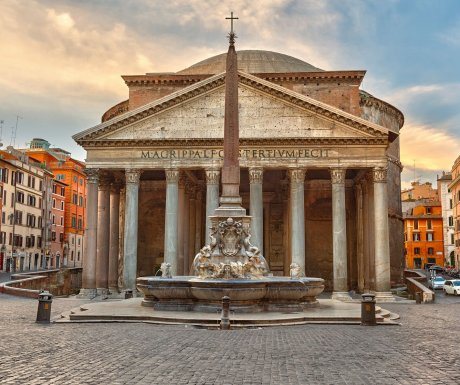 Spanish Steps
You would never think it, but it is believed that the Spanish Steps are the most photographed attraction in Italy which is quite an accomplishment in a city bursting with as many sites and attractions as Rome. Now returning after a years hiatus to be repaired and renovated, the Spanish Steps are once again open to the public.
Visitors will be in good company as they ascend the steps of the famous stairway, joining the likes of Audrey Hepburn and Gregory Peck who shared a scene there in the Hollywood classic, Roman Holiday, and Matt Damon in the film version of The Talented Mr Ripley. Visitors will revel in the seasonal and festive changes the steps undergo throughout the year, including the assembling of a Christmas manger on the first landing.
Spanish Steps
You would never think it, but it is believed that the Spanish Steps are the most photographed attraction in Italy which is quite an accomplishment in a city bursting with as many sites and attractions as Rome. Now returning after a years hiatus to be repaired and renovated, the Spanish Steps are once again open to the public.
Visitors will be in good company as they ascend the steps of the famous stairway, joining the likes of Audrey Hepburn and Gregory Peck who shared a scene there in the Hollywood classic, Roman Holiday, and Matt Damon in the film version of The Talented Mr Ripley. Visitors will revel in the seasonal and festive changes the steps undergo throughout the year, including the assembling of a Christmas manger on the first landing.
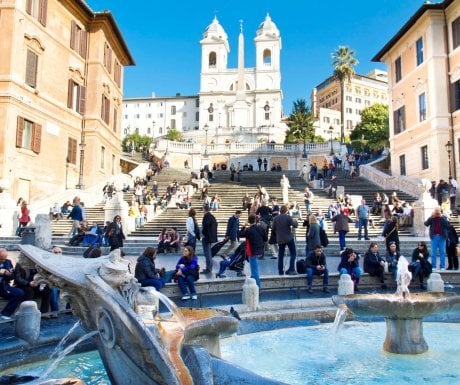 Vatican City
This miniscule sovereign state may be the smallest country in the world, one that fits comfortably within the centre of Rome, but what it lacks in size it makes up for in significance. For Catholics the world over, The Vatican City is the beating heart and centre of Christendom. Not only is the Vatican home to the papal residence, it is also home to popular landmarks, St Peters Basilica, the Sistine Chapel and the Vatican Museums.
Vatican City
This miniscule sovereign state may be the smallest country in the world, one that fits comfortably within the centre of Rome, but what it lacks in size it makes up for in significance. For Catholics the world over, The Vatican City is the beating heart and centre of Christendom. Not only is the Vatican home to the papal residence, it is also home to popular landmarks, St Peters Basilica, the Sistine Chapel and the Vatican Museums.
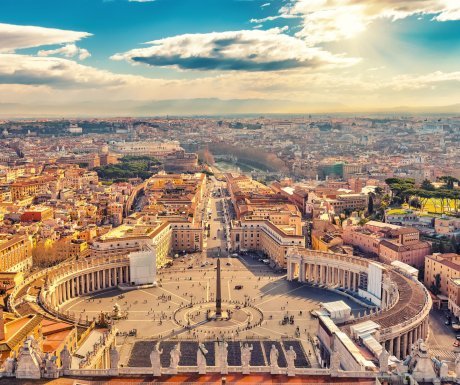 St Peters Basilica & the Sistine Chapel
Residing prominently in the centre of Vatican City is the iconic domed church of St Peters Basilica. Constructed atop of Vatican Hill by Emperor Constantine, the first Christian ruler of Rome, the basilica marks the resting place of the apostle, Saint Peter. The distinctive structure we know today is owed in part to the design of the renowned sculptor, artist and architect Michelangelo, who was handed control of the restoration of the basilica in 1547.
One of the best ways to appreciate the basilica is to ascend the steps or take the lift to the top of the cupola (or dome) atop the church to the viewing platforms. Although said to be an uneasy climb, visitors are rewarded with views that are dubbed as being some of the best in the city.
Finally, the extravagantly designed and intricately decorated with hand-painted frescoes, the Sistine Chapel is one of Vatican Citys great treasures. But its what lies above that is the real crowning glory, if you crane your necks upwards you are rewarded with Michelangelos most famous of frescoes which covers every inch of the ceiling.
St Peters Basilica & the Sistine Chapel
Residing prominently in the centre of Vatican City is the iconic domed church of St Peters Basilica. Constructed atop of Vatican Hill by Emperor Constantine, the first Christian ruler of Rome, the basilica marks the resting place of the apostle, Saint Peter. The distinctive structure we know today is owed in part to the design of the renowned sculptor, artist and architect Michelangelo, who was handed control of the restoration of the basilica in 1547.
One of the best ways to appreciate the basilica is to ascend the steps or take the lift to the top of the cupola (or dome) atop the church to the viewing platforms. Although said to be an uneasy climb, visitors are rewarded with views that are dubbed as being some of the best in the city.
Finally, the extravagantly designed and intricately decorated with hand-painted frescoes, the Sistine Chapel is one of Vatican Citys great treasures. But its what lies above that is the real crowning glory, if you crane your necks upwards you are rewarded with Michelangelos most famous of frescoes which covers every inch of the ceiling.
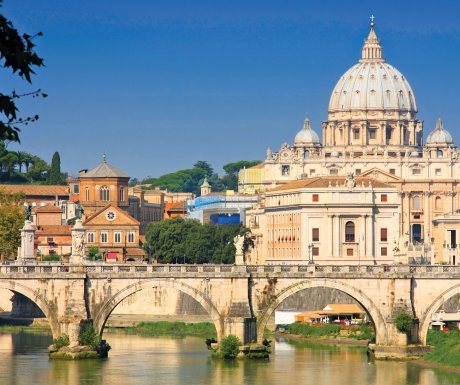 Nick Munday is Managing Director at Classic Collection Holidays.
If you would like to be a guest blogger on A Luxury Travel Blog in order to raise your profile, please contact us.
Nick Munday is Managing Director at Classic Collection Holidays.
If you would like to be a guest blogger on A Luxury Travel Blog in order to raise your profile, please contact us.Did you enjoy this article?
Receive similar content direct to your inbox.


Great article you have here my friend. I’ve been planning a trip to Rome with friends. And I’ll definitely bookmarking this very detailed and informative article of yours for future reference!
A wonderfully written piece! I took the liberty of bookmarking this article when I visited the charming city on my recent excursion with my wife. I would love to read more about other italian destinations!
– Bernard